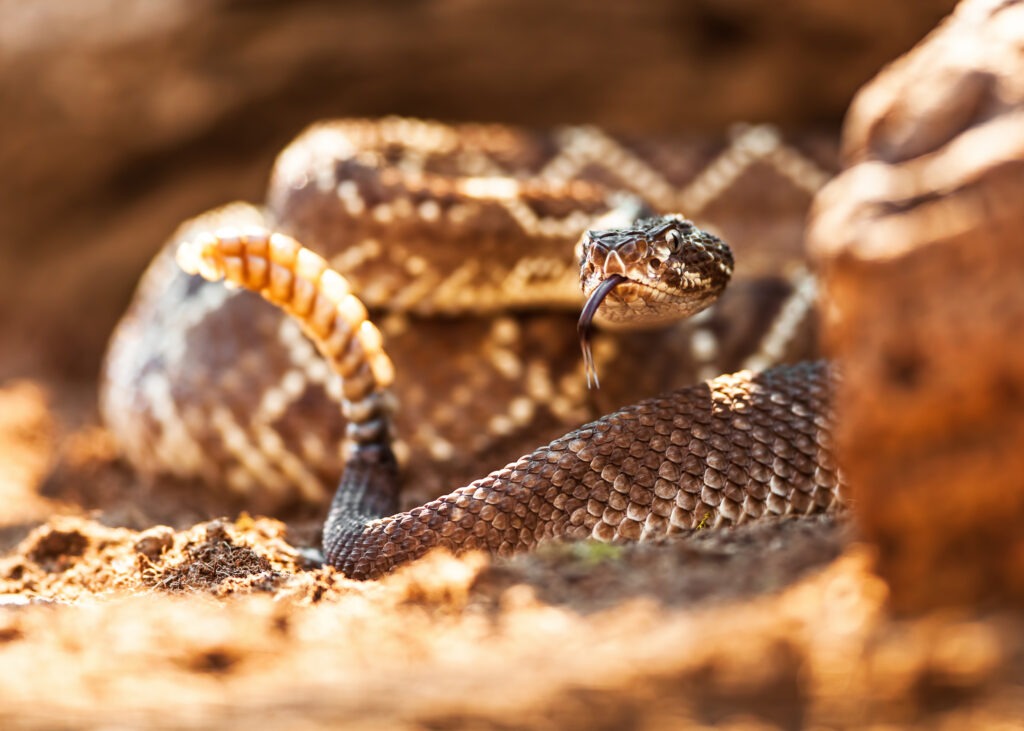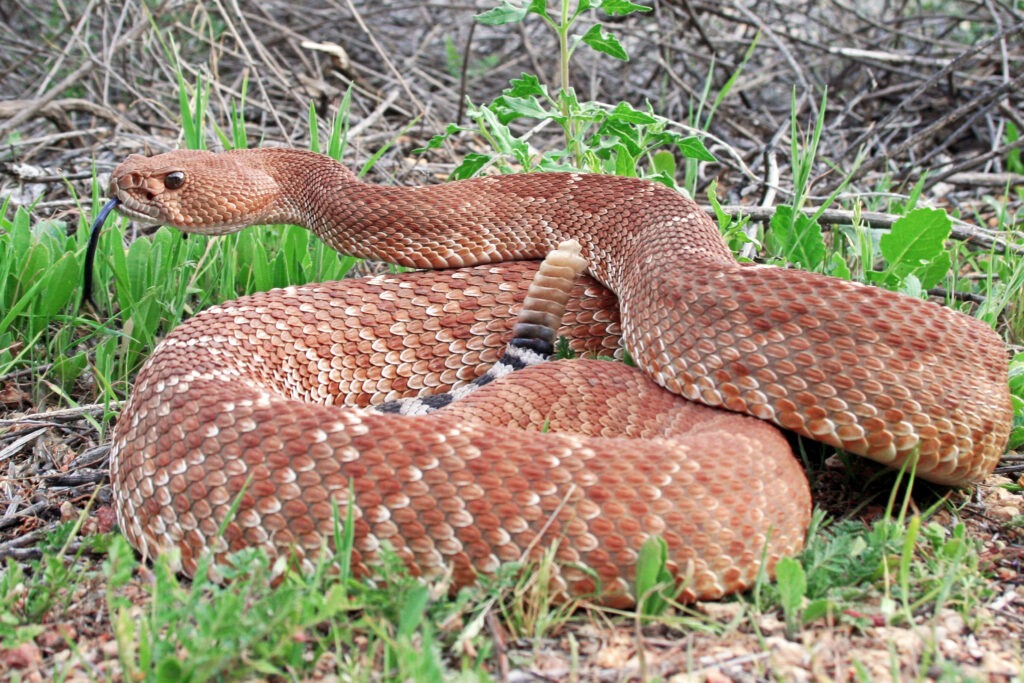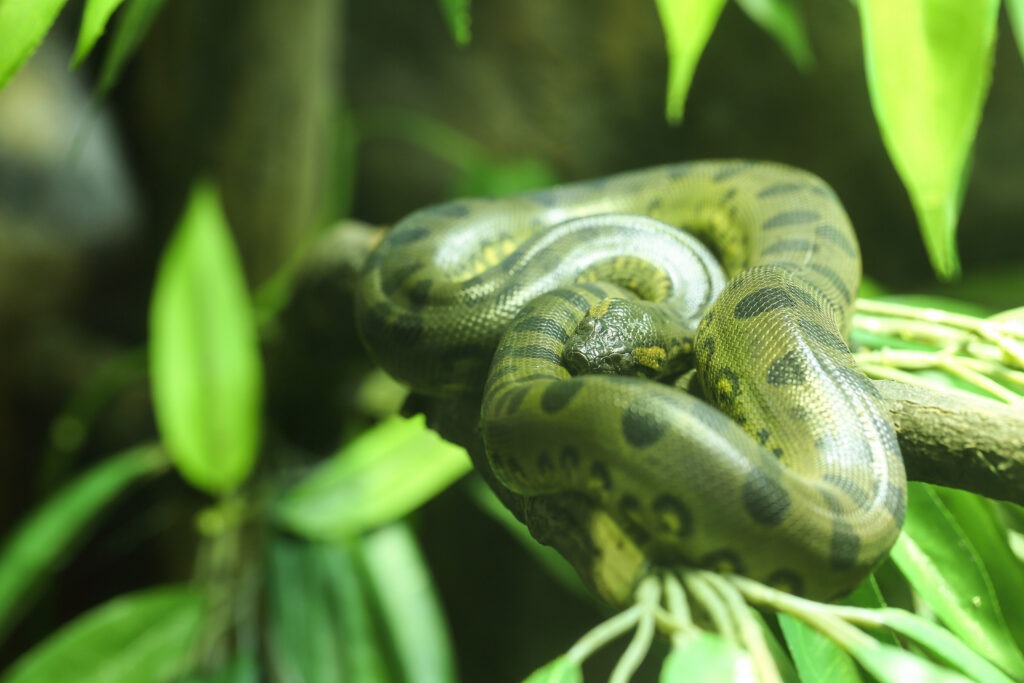Rattlesnakes have created quite a name for themselves in myths and legends. But how can you tell which snakes are record-breakers and which ones are within the usual size limits for their species, and what is the world record rattlesnake length?
The longest rattlesnake on record is an Eastern Diamondback Rattlesnake with one specimen reported to be 8 feet and four inches. Commonly, these large snakes are found in Florida and throughout the Southeastern United States.
Eastern Diamondback snakes take the cake in more ways than one for rattlesnakes. They are also known to be the heaviest rattlesnakes, coming close to 33 pounds in rare instances.
On average, they are about 5 to 6 feet long, but there are large snakes that come in closer to the 7-foot length. We’ll talk more about rattlesnakes below, as well as some of the largest snakes around the world.

Rattlesnake Record Lengths
The longest and heaviest rattlesnake species is the eastern diamondback.
They live in the Southeast United States throughout North & South Carolina, Louisiana, Georgia, Flordia, Alabama, Mississippi, and the Florida Keys.
They prefer to live in forests, plains, and sandy hills, and swamps and marshlands, though they can swim well.
These places also are home to other rare creatures, but they are a rapidly shrinking habitat. The more that humans move into the habitat of eastern diamondbacks, the more we will have encounters with them.
During the cold winter months, they will often find coverage in gopher and tortoise burrows, where they try to escape the cold and wait out the winter.
Among all rattlesnake species, it is important to be aware of their identifiers.
No one wants to wander upon a 7-foot snake and not know which snake it is, and how dangerous it can be. Some of the largest snakes in the world are not dangerous to humans at all, but you’ll want to know that before you approach them. So let’s read about some of the rattlesnakes defining features.
Defining Features of Rattlesnakes
Rattlesnakes are often identified by their triangular-shaped heads and tan and brown coloring, and are most distinguished by their rattling tail.
These rattles are actually hollow, specialized scales that are designed to shake and rattle loudly when they are vibrated. A rattlesnake’s rattle grows with every shed they go through.
This means, that the more they shed their skin, the larger and louder their rattle becomes. It is also possible for rattlesnakes to lose their rattle and still be just as alive, poisonous, and predatory as there are with them.
These snakes can make quite the statement with their rattling tails.
Plus according to the San Diego Zoo, rattlesnakes are among the newest and most highly evolved snakes in the world (source).
This is true not just because of their specialized rattle which they use to warn off predators, but also because of the heat-sensing organs that allow them to see and hunt in the dark, and because of their specialized fangs, which are like hypodermic needles with hinges that allow them to fold up when not in use.
Not only do they vibrate their tails to give off the rattle sound, but they MIGHT also hiss to let you know they are there. This gives you a great idea of what to listen for when you are out in the woods!
Obviously, these snakes are very evolved and will continue to evolve and change with their surroundings.
Types of Rattlesnakes
Let’s go through the list of some rattlesnake species and subspecies and where they are located in the United States:

- Western Diamondback – Found in the southwestern US around Texas and Mexico. It holds the greatest number of snakebites in the US.
- Timber Rattlesnake – Found all along the east coast, at times stretching from Canada and Maine all the way down to Florida.
- Eastern Diamondback Rattlesnake – Found in the southeastern US and often in Florida and Georgia.
- Massasauga – Found in midwestern North America. It mainly goes from the edge of the Canadian border to northern Mexico, stretching diagonally across the states.
- Pygmy Rattlesnake – Found in Georgia and North & South Carolina. It has two subspecies called the Carolina Pigmy Rattler and the Dusky Pigmy Rattler.
- Mojave Green – Found in the southwestern US and Mexico, at times stretching to New Mexico. It is often considered one of the world’s most potent venomous rattlesnakes.
- Sidewinder – Found in Mexico and the southwestern US. It travels as fast as 18 miles per hour.
- Prairie Rattlesnake – Found in the central US prairie, from Canada to Texas and from Idaho to Iowa.
- Northern Pacific – Found along with the western United States and in the Baja California peninsula.
- Black-Tailed Rattlesnake – Found in southwestern US and Mexico. It has four subspecies called the Northern black-tailed rattlesnake, Mexican black-tailed rattlesnake, and the Oaxacan black-tailed rattlesnake.
- Red Diamond – Found in Mexico, Southwestern US, like California and Baja California. The largest recorded was 5 feet and 3 inches. It has 3 subspecies including the Island Red Diamond Rattlesnake, the San Lucan Red Diamond Rattlesnake, and the Red Diamond Rattlesnake.
- Tiger Rattlesnake – Found in the southwestern United States and northwestern Mexico.
- Speckled Rattlesnake – Found in the southwestern United States and northwestern Mexico. It was named after a doctor who studied rattlesnake venoms whose name was Silas Weir Mitchell. (Its scientific name is cortalus mitchellii)
- Rock Rattlesnake – Found in the southwestern United States and north-central Mexico. It has 4 subspecies of Branded rock rattlesnake, mottled rock rattlesnake, Durango rock rattlesnake, and Tamaulipas rock rattlesnake.
- Black-Speckled – Found in the southwestern United States and northwestern Mexico.
As you notice from this list, there are quite a few species and subspecies of rattlesnakes. Throughout the entire US, you are bound to find at least one of these species slithering around.
It may be helpful to know which rattlesnakes roam your area and what you can do to spot them and get out of their way before they decide to make you back off!
They have a 7 foot Eastern Diamondback Rattlesnake named Edgar in captivity in a Florida Zoo.
He is 19 years old and has been living in captivity his whole life. He only weighs about 20 pounds but is about a foot longer than a regular refrigerator. This particular snake is also albino and is very old in comparison to the average lifespan of a snake.
There have also been sightings of rattlesnakes where snakes have been crossing the road or were visible in some other way. Many of these snakes were claimed to be over 7 feet long.
There are often reports of big snakes which require a great deal of evidence in order to know for sure that it is the length people claim it to be.
For example, in 2009, someone claimed to had found a 15-foot diamondback rattlesnake in Florida, but the pictures had been altered to make it so large. With only photographic evidence, it’s hard to prove just how big a snake really was.
Other Large Snakes in the United States
There are a variety of other large snakes which don’t have such a harmful bite. One of these snakes is the Eastern Indigo Snake which is native to the United States. Particularly it is in Georgia, and parts of Florida.
It is a protected snake because of its increasingly low numbers.
It is the longest snake in North America, reaching as long as 8 and a half feet and weighing around 11 pounds. Commonly though they are more like 5 to 6 feet in length. Uncommon among other snake species, they are known to prey on venomous snakes and are immune to their venom.
Black Rat Snakes are also pretty long snakes.
They measure to be around 3 to 5 feet but sometimes grow longer than 6 feet. They are found in quite a few states including the southeast, eastern, and Midwestern states. They are also not venomous, but will still strike if they feel threatened.
It is also commonly mistaken for a rattlesnake because it will also vibrate its tail when it feels threatened, even though it doesn’t have a rattle.
Generally, they are very beneficial wherever they are because they eat pests such as rats, mice, gophers, and others. So even though they are slithering snakes, they are a good one to have around.
The bull snake is another large snake that can reach up to 8 feet long!
It is considered a subspecies of Gopher Snakes and is found throughout North America including central and northern Mexico, and parts of Canada. It is non-venomous and another giant to add to the collection of information about large snakes.
Gopher snakes do eat gophers, which is where they got their name, but they also eat other rodents such as rats and mice, as well as birds, and other small prey.
They often fight for territory with rattlesnakes and have been known to kill them in a fight. Gopher snakes are nice to have around to keep the rattlesnake population lower in your area.
The Largest Snakes in the United States
Rattlesnakes are common in the United States and are the largest venomous snake we have, but there are a few other venomous species.
The US is also home to cottonmouths and copperheads which are also venomous pit vipers like the rattlesnake. We also have coral snakes which have the most potent venom of any snake in North America.
Fortunately, they are shy, reclusive snakes that are rarely seen and rarely bite humans. But among all these snakes within the states, we have yet to hear of some even larger snakes that are throughout the world.
The largest snake in the world is the Reticulated Python.
According to Guinness World Record, the longest found reticulated python was in Celebes Indonesia in 1912, and it was 32 feet long and 9 and a half inches. That is a long snake! It was shot in Indonesia and living in the wild, while there is also a world record on the longest snake in captivity.
Medusa is the largest reticulated python in captivity, it is owned by Full Moon Productions and was measured in 2011 to be 25 feet and 2 inches long. To get measured she was held by 15 men because she also weighs around 350 pounds.
When she was measured, she was 10 years old.
Reticulated Pythons are native to Southeast Asia. It has been reported in the past to have eaten humans, yet is often hunted by humans for its skin and medicinal use, or as a pet. They are amazing swimmers and through the use of this skill have made a home on quite a few small islands.
The reason it is called ‘reticulated’ is because of its net-like color pattern.

Another really big snake in the world is the Green Anaconda. It doesn’t quite reach the same lengths as Reticulated Python, but its weight goes far beyond.
They can grow to be 29 feet long and weigh more than 550 pounds. Oftentimes, they can have a diameter of 12 inches. That is the size of a ruler just in width!
They live in forests with swamps and rivers and can often be found in the Amazon.
They eat pigs, birds, turtles, deer, or even jaguars.
While they don’t kill their prey with venom like rattlesnakes, they coil themselves around their prey and squeeze until they can no longer breathe and die of suffocation. They will eat their prey whole, no matter how small or large it is.
No other snake is as heavy as the anaconda, and no rattlesnake will ever measure up to its width, length, or size.
There are quite a few giant snakes throughout the world and throughout all different types of terrain. No matter where you go, you are bound to find a least a couple of big snakes, or even just little garden snakes. Snakes play a critical role in the circle of life.
In the United States, we don’t have giants, be we do have pretty large poisonous snakes that can be quite harmful! Let’s see if one day we can find a rattler larger than 8 feet!
As an Amazon Associate I may earn a small comission from qualifying purchases if you click to Amazon from my site and choose to make a purchase. You can read my complete affiliate disclosure for more details.
